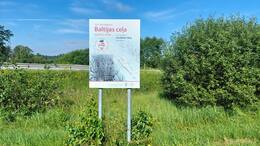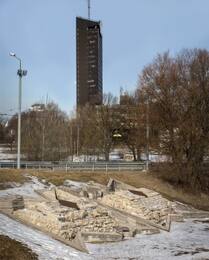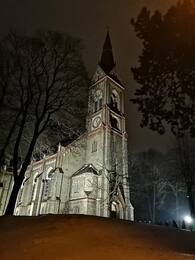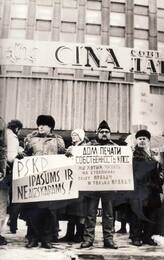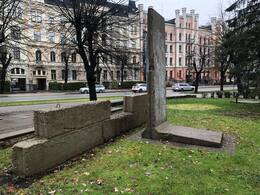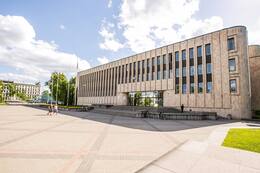From the Awakening to the restoration of Latvia's independence
Day 1.
63 km
Kekava - Zaķusala - Torņakalns - Riga center
Practical info
* The itinerary is intended as a guide - how to optimally travel around a region or country with the aim of getting to know its military heritage;
* Driving distance: ~63 km. Most of the objects in the center of Riga can be reached on foot, enjoying the magic of the center of Riga and its parks
* There are many places to eat and stay along the route.
* Memorials can be viewed at any time
* The traveler plans how many of the recommended objects and places he can explore in one day;
* Before traveling, you should check the opening hours of sightseeing places (museums, collections, fortifications, etc.);
* For places where advance booking is required (local guides, private collections, etc.), a visit must be booked, specifying the date and time. If the trip is cancelled, the places booked must be informed;
* Accommodation must be booked in advance. Accommodation may be unavailable during the summer season, especially on the coast. Some catering establishments may not be open during the winter season;
* Choose not only summer for your trip, but also other seasons;
* Visit tourist information centers where you can get additional information, brochures, and maps.
Sights
Commemorative sign dedicated to the 25th anniversary of the Baltic Way
During the campaign “Baltic Road” on August 23, 1989, people from Kurzeme and Zemgale - Liepāja, Saldus, Dobele, Kuldīga, Ventspils, Talsi, Tukums and their surroundings arrived on the Riga - Bauska highway section. The main task was to achieve the most even distribution of people and continuity of the chain. Where there was not enough arm length, people were asked to use flags, belts, or even jacket sleeves, just so that the blood circulation of community in this artery would not be interrupted. In total, about 400,000 Latvian residents participated in this campaign.
The memorial sign dedicated to the 25th anniversary of the Baltic Way in Ķekava municipality, at the 25th kilometer of the Riga-Bauskas highway near the Ķekaviņa River, was unveiled on August 23, 2014. Its ceremonial opening was attended by the Prime Minister of the Republic of Latvia, Laimdota Straujuma, a long-time employee of the State Joint-Stock Company “Latvijas Valsts ceļi” and a member of the Baltic Way, Uldis Birzleja, and other attendees. In 2014, 10 such memorial signs were erected on the Baltic Way section of Latvia in memory of this event. Four memorial signs were erected in Estonia, and nine in Lithuania. On July 30, 2009, the Baltic Way campaign was included in the UNESCO “Memory of the World” documentary heritage list.
Barricades Memorial "Eyes"
The environmental art object “Eyes”, created by Igors and Ruta Dobičin in 1991 (restored in 2012) in memory of the barricades, is dedicated to the 30 x 60-meter square. Dolomite and concrete pile and paving elements, similar to graphic signs, are placed in the 30 x 60-meter square, forming a cryptogram resembling a stylized “face”. A plaque is built into the symbolic ensemble with the inscription: “Eyes. Dedication to the guards of the Television Center during the barricades in 1991. There is strength in unity”. In 1991, a sculpture by Ojārs Feldbergs “By the Fire” was installed near the LTV building. The two-meter-high sculpture, carved in granite, contains a metaphor for people from four Latvian regions gathering around a common fire.
Television, like radio and the printed press, played a very important role during the Awakening not only as a source of information, but also as a driver of this process. The LTV program “Labvakar” (Good Evening), launched on January 31, 1988, gained immense popularity. It was the first program in Latvia in which Edvīns Inkēns, Ojārs Rubenis and Jānis Šipkēvics spoke about many previously forbidden topics. LTV broadcast live broadcasts from Latvian Popular Front congresses and mass demonstrations, and produced interviews and reports on politically important issues.
During the barricades in January 1991, the LTV building was one of the important objects guarded by volunteers. This was a difficult task, as the building is located in a large and easily accessible area. The barricades participants guarded the direct approaches to the building, as well as blocked the Salu bridge at night. From the Daugava side, the LTV center was guarded by three fishing boats. Remaining intact during the barricades, the LTV building was invaded by paratroopers of the USSR Army and members of the OMON unit during the August 1991 coup. After it was captured on August 19 at 7:30 p.m., the TV stopped broadcasting, but resumed its work after the coup failed and after the Soviet paratroopers left the LTV building on August 21 at 7:45 p.m.
Riga Lutheran Evangelical Lutheran Church
In the second half of the 1980s, meetings of the “Revival and Renewal” movement were held at Torņakalns Church. It was a group of pastors and parish activists of the Latvian Evangelical Lutheran Church, which on June 14, 1987, distributed a document on the founding of the group and its goals with an invitation to all LELB clergy to join this group. The group invited Archbishop Īriks Mesters and the Consistory to address the Councils for Religious Affairs of the Latvian SSR and the USSR with a request to jointly discuss, evaluate and possibly revise some points of the Regulation on Religious Associations of the Latvian SSR, which no longer correspond to the real situation and hinder the democratization process in the church.
On July 28, 1987, the first meeting of the group took place, where the basic principles of the organization renamed the "Revival and Renewal" movement and proposals on church-state relations and the internal life of the LELB were adopted. The LELB Consistory, under the leadership of Archbishop E. Mester, in July and August 1987, carried out repressions against members of the "Revival and Renewal" movement Jānis Priednieks, Roberts Akmentiņš, Aivars Beimanes and Modris Plātes, removing them from their positions. In December 1987, members of the movement Māris Ludviks and Jānis Kārkls were forced to leave Latvia. In April 1989, at the LELB Synod, members of the movement became the leaders of the LELB, and Kārlis Gailītis became the archbishop.
Arcadia Park
On April 27, 1988, about 10,000 people protested against the construction of the metro in Riga at a rally organized by the Environmental Protection Club in Arkadija Park. The demonstration began on the Esplanade at the Rainis Monument, but continued with a march along the Freedom Monument across the Stone Bridge to Arkadija Park, stretching for 2.5 kilometers. It was the first large rally of the Awakening era – unauthorized, but not prohibited. The Arkadija branch of the VAK held its meetings in the wooden building of the former Arkadija cinema (burned down in 2006, demolished two years later). Environmental activists gathered here, among whom ideas about nature protection were born, which gradually grew into demands for the restoration of Latvia’s independence.
In the summer of 1988, the Arkadija Park stage (burned down in 2000) was a gathering place for the radical national opposition. On July 10, the founding meeting of the Latvian National Independence Movement was held in the park, which was attended by about 2,000 people. As a venue for various mass events, Arkadija Park retained its importance throughout the Revival period. In November 2023, information stands of the municipal agency “Rīgas dārzi un parkis” “The wooden building of the Arkadija Cinema – one of the shacks of the Third Revival” and “Protest against the construction of the Riga Metro – the beginning of the restoration of Latvian independence” were installed in Arkadija Park.
Former Press House building
The publishing house and printing house complex built in 1978 housed the editorial offices of all newspapers and magazines of republican importance. Journalists played a very important role in the course of the Awakening, as their presence in the Press House facilitated mutual contacts and organization. It was here that the Latvian People's Front began to take shape. The idea of the need for such an organization was expressed at the plenum of the Creative Unions on June 1-2, 1988, and already on June 22, Viktors Avotiņš read its first, unpublished manifesto at a meeting of journalists. However, the idea was only realized after the Writers' Union and its chairman, Jānis Peters, became involved in its implementation.
The Press House belonged to the Central Committee of the Communist Party of Latvia, which had taken over and effectively monopolized the publication of all newspapers and magazines of republican significance. All profits from the publishing house and printing house went to the treasury of the Central Committee of the Communist Party of Latvia. During the Awakening, as efforts to restore Latvia's independence intensified, the issue of ownership rights to the Press House also arose. After the adoption of the Declaration of Independence on May 4, 1990, a dual government was effectively formed, as some Latvian institutions refused to submit to the government of the Republic of Latvia. The Latvian government established the Latvian Newspaper and Magazine Publishing House, but the USSR Council of Ministers and the Central Committee of the Communist Party of Latvia led by Alfred Rubiks considered the Press House to be the property of the USSR. The situation escalated in November 1990, when OMON attacks on the Press House took place, but on January 2, 1991, OMON completely took over the Press House and stopped printing publications supporting the LTF, expelling their employees from the Press House.
Demolition work on the Press House printing house began in 2020. The construction of the Press House block is currently underway, which will completely change its former appearance.
Monument "The Wall - Divider and Uniter"
The memorial site at Elizabetes Street in Kronvalda Park was opened in September 1992 after a fragment of the dismantled Berlin Wall was exhibited in Riga. In 1992, it was combined into a single memorial ensemble with a fragment of the concrete wall erected near the Saeima building during the 1991 Barricades and installed in Kronvalda Park at Elizabetes Street, next to the World Trade Center. An altar for laying flowers is attached to the monument with an inscription in Latvian and German: “After the exhibition of the Berlin Wall Museum “Haus am Checkpoint Charlie” in Riga in November 1990, the museum director Dr. Rainer Hildebrands presented this fragment of the wall to the capital of Latvia.”
In 2011, the monument was restored and the territory was improved. An information plaque with text in Latvian, German, English and Russian was installed. The barricade blocks were supplemented with historical inscriptions in Latvian and Russian: “The Berlin Wall divided us, the Riga Wall unites us. Let us only love our neighbor, and pray to God for our enemy.”
Riga Congress Center
The Congress Hall (at that time the Political Education Hall of the Central Committee of the Communist Party of Latvia) was one of the few meeting rooms in Riga where a larger number of people could gather. During the revival, a variety of events were held there - congresses of the Latvian Popular Front, founding events for various public organizations, discussions on history, etc. On June 1-2, 1988, an expanded plenum of the board of the Latvian Writers' Union was held here with the participation of other creative unions, to which the leadership of the Latvian SSR was invited. Many painful problems were discussed, but the effect of a bombshell was created by the speech of the well-known political commentator and 1940s activist Mavriks Vulfsons, in which he declared that there had been no socialist revolution in Latvia in 1940.
On June 14, 1988, a rally was held in memory of the victims of mass deportations at the Congress House. It was the first officially authorized rally, at which both officials (for example, the Secretary of the Central Committee of the Latvian Communist Party Anatolijs Gorbunovs) and representatives of the public (journalists Andrejs Cīrulis, Edvīns Inkēns, a representative of the Environmental Protection Club Valdis Turins, a priest Juris Rubenis, dissident Eduards Berklavs, etc.) spoke. The rally ended with a march to the Freedom Monument. During the march, Konstantīns Pupurs carried the Latvian flag. Many posters at the rally were quite radical, for example, "No — to the histories of Drīzulis and Karaļuns", "No to the kangaroo Voss of our day!" Modris Lujāns held a poster on which were pasted photos of Stalin and Ribbentrop with the caption "Curse on the murderers of the people" and photos of August Voss and other leaders of the Latvian Communist Party with the caption "No to the kangaroos!" A few days later, at the plenum of the Central Committee of the Latvian Communist Party, First Secretary Boriss Pugo condemned certain individuals and groups who “under the guise of reorganization tried to give the rally a distinctly nationalistic, provocative orientation.” A criminal case was initiated against M. Lujāns, but on September 30 the Supreme Court of the Latvian SSR fully acquitted him.
The next turning point in Latvian history was the 1st Congress of the Latvian Popular Front on October 8-9, 1988, which was also held at the Congress House. On December 10-11, the Forum of the Peoples of the Latvian SSR was also held here.
In Ķekava region: https://turisms.kekava.lv/ko-piedzivot/
In Riga: https://www.liveriga.com/lv/apmekle/ko-redzet
Places to eat
In Ķekava: https://turisms.kekava.lv/kur-paest/
In Riga: https://www.liveriga.com/lv/apmekle/est-dzert
Places to stay
In Ķekava: https://turisms.kekava.lv/kur-naksnot/
In Riga: https://www.liveriga.com/lv/apmekle/ko-darit




